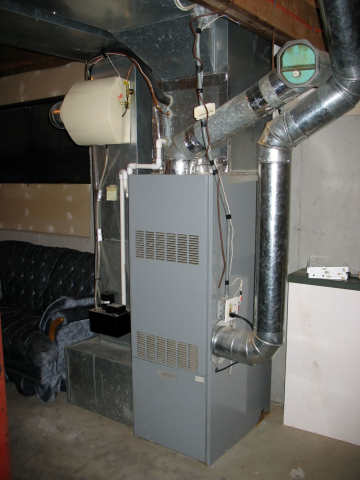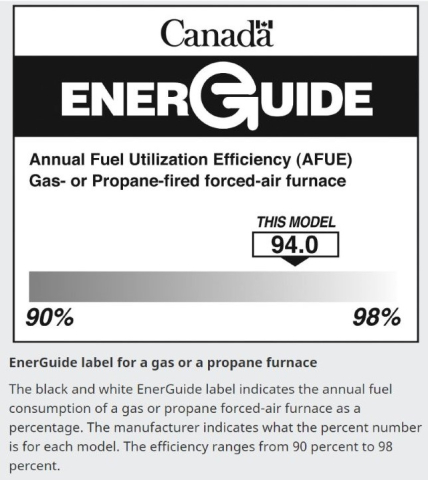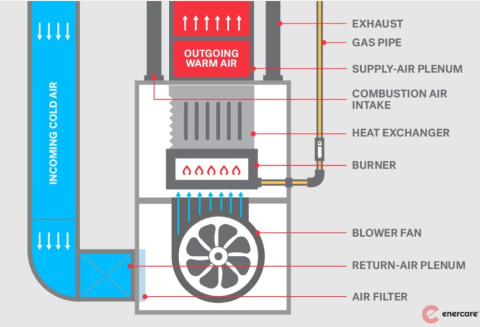
Furnace Maintenance


Furnace Maintenance
Regular furnace maintenance can help stop costly furnace problems and decrease your energy bill leaving your home cozier during the cold winter months. The Indoor Air Quality Association (IAQA) says annual heating, ventilation, and air-conditioning maintenance can help save up to 30% on gas bills and lower your risk of furnace repair by 95%.
All furnaces have an AFUE rating. AFUE stands for Annual Fuel Utilization Efficiency. This rating measures the furnace's energy efficiency and the percentage of energy converted into heat. The higher the percentage, the better the energy efficiency of the furnace.
Furnaces also come with an EnerGuide label, as shown below:

Parts of a Furnace:
Thermostat – a device that controls the temperature inside your home connected to your furnace.
Control Board – a circuit board designed to send and receive signals from the thermostat to heat the home throughout its system.
Burners – Outlets inside the furnace that is lit in controlled flames.
Igniter – lights up the burners to produce heat for the home.
Blower Fan – a fan with a motor that 'blows' the heat through the ducts to warm the house.
Flame Detector – this is a safety component in the burner area. If it does not detect an active flame, it will shut off the furnace to prevent a gas leak.
Heat Exchanger – Keeps the combustion process separate from the air entering the home with thin-walled metal tubes. The Heat Exchanger warms the cool air, and the blower redirects the warm air through the plenums (vents, ducts) to warm the home.
Plenums – Supply air plenums with direct warmed air to the ducts. The Return-air plenums carry the air in the home back into the furnace to be reheated and redistribute heat to the house.
Gas Valves – Regulates the pressure of gas that comes into the furnace from a tank of Liquid Propane Gas (LPG) or Natural Gas supply line from outside the home.
Air Filter – Furnaces come with an Air Filter that keeps out dust and debris from going into the furnace with the cool air. These filters are interchangeable and should be changed every three months.
Transformer – This supplies the furnace with electricity and regulates how much electricity so that the furnace has the correct voltage.

How do Furnace’s work?
For example, a natural gas furnace works by activating (turning on) the thermostat. The gas valve opens and regulates the fuel pressure for the burners. Then an igniter or pilot flame lights the burners directly into the heat exchanger. The exhaust gases flow through the heat exchanger inside the furnace, heat the metal, and vent it through a pipe to the outside. After this, the blower moves the air over the hot surface of the heat exchanger. This hot air is pushed throughout the ventilation system, heating every room as it flows. Once the heat in the home is at the temperature the thermostat is set at, the furnace will turn off.
Furnace Models and Fan Speeds:
The Canadian government has regulations that furnaces with multi-stage motors or variable-stage fan motors can be sold.
A Multi-Stage Furnace – has two levels of heating operations. This type is better at managing the temperature and comfortability of your home. You can also keep the fan constantly running to circulate the air in the house, but if you leave the fan on continuously may increase your electric bill and burn more fuel.
The Variable Stage Furnace runs at a range of speeds. As it's in use, the furnace monitors data from your HVAC system, so the blower motor automatically adjusts the speed and delivers the proper amount of airflow based on the home's heating needs.
If you have blocked or dirty furnace filters, the HVAC system automatically adjusts the fan speed.
If you are looking to buy a new furnace, there may be a few things to consider:
- The age, layout, and size of your home
- Duct air flow capacity
- The number of windows you have
- How well insulated your home is
- Which kind of energy source it uses (natural gas, propane, electric, or oil)
Professionals can tell you which option is best for you and your home. It is recommended to always have a professional inspect your furnace. Inspection of your heating system should include the following:
- Cleaning your furnace gas burners. Cracks can cause dangerous monoxide leaks or even a fire.
- Observing airflow and blower operations to make sure the furnace is running correctly
- Checking the gas valve
- Inspecting the pilot light
If the furnace is malfunctioning, you can also check the following:
- Ensure the thermostat setting is on 'heat'; otherwise, your furnace won't be alert to start.
- Furnace Filters – a clogged filter can cause your furnace to overheat and shut down as a safety precaution. It can also stop creating heat and spreading it throughout the home.
- Circuit Breaker – the furnace breaker may have tripped. Check the circuit board to check if it's in the correct position.
- The Furnace Switch – The furnace switch looks like a regular light switch. If turned off, it might take a few minutes to resume normal operations when switched back on.
Furnaces can do more than produce heat. They also help with airflow, distribution, and filtration all year. If your furnace is 15 years or older, frequently needs repairs, makes loud noises, or has an increase in your electric bill, it may be time to replace your furnace.
By: Tricia Cook, Content Navigator